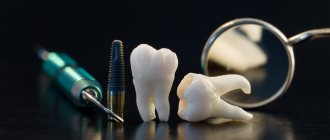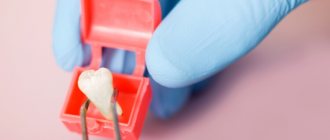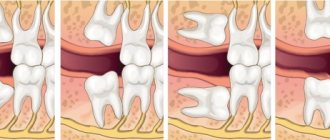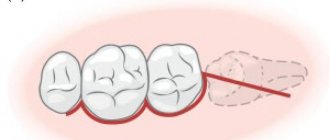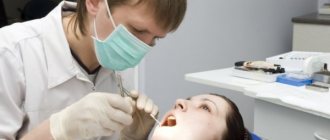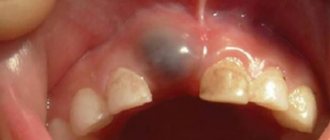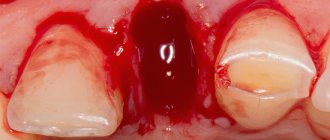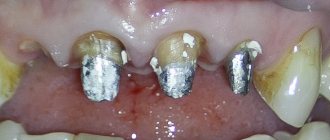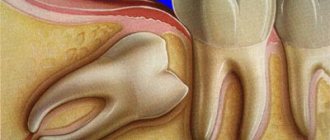In the practice of dentists, there are often cases when a patient’s tooth is fully formed, but does not erupt. It is called “retained”, and the problem is treated with special methods. Teeth that are formed but “stuck” inside the jaw can cause inflammatory processes: pericoronitis, periodontitis, periostitis, abscess, phlegmon, etc. Treatment is carried out using various methods, from removal to wearing specialized braces. Reduce the risk of impacted tooth Prevention helps, for example, wearing trainers that prepare the jaw for the appearance of new teeth.
What is retention? Why does pathology develop? Symptoms and diagnosis
Retention is considered one of the most common teething anomalies. Most often, problems arise with the lower and upper “wisdom teeth”, which grow incorrectly. They are usually encountered by adults. In children, a common impacted tooth is the canine of the upper jaw. The second premolars of the mandible often present unpleasant surprises.
Symptoms of unerupted teeth vary by owner. The problem may not manifest itself at all, or it may cause constant visits to the dentist. The variety of symptoms and their absence is due to the fact that the incorrect position of a tooth or its incomplete eruption is an almost natural phenomenon for humans. Approximately 35-45% of “wisdom eights” in adults are impacted teeth . Difficulties begin to arise when such a molar or premolar causes irritation of the soft tissue around it. Based on indirect signs - pain or inflammation - the doctor identifies the “wrong” tooth.
Semi-retinated teeth are visible immediately at the first examination: they partially grow, but not completely. Such partially erupted molars and premolars cause many more problems: being partially located in the soft tissues, they almost always cause inflammation. There is no need to specifically diagnose them: the doctor almost always finds such teeth during a routine examination.
Finding completely impacted teeth is a real quest. They may not be visible at all, because they are located under the existing elements of the dentition. In this case, there is only one diagnostic option: you need to take a full picture of the jaw, which will clearly show the whole picture. Below in the picture is a selection of examples. Impacted teeth are marked in red or with arrows.
Examples of impacted teeth on x-ray
Types of dental retention
There are many classifications of dental retention. One of the most popular methods of division is by degree of eruption. Thus, there are semi-impacted teeth , which are partially visible in the gum, and completely hidden - located under the gum or bone tissue. The latter are not available for palpation. If the impacted tooth is located in the gum tissue, the diagnosis will say “with tissue immersion,” but if it is located in the bone, “with bone immersion.”
Another classification method takes into account the position of the molar, canine or premolar:
- vertical,
- horizontal,
- corner.
Horizontal teeth can also be transverse, sagittal or oblique, and angular teeth can be mesial, distal, lingual or buccal angular. Rarely, but still there are reverse impacted teeth - these are elements that grow “upside down”, that is, their crown is directed towards the jaw.
What are the stages of removal?
The procedure for removing both dystopic and impacted wisdom teeth is similar.
At the initial stage, as before any serious surgical intervention, the doctor collects an anamnesis, conducts an examination, examines x-rays and chooses the method of tooth extraction, as well as the method of anesthesia.
The patient is given an anesthetic drug by injection into the gum, in the area of the extreme molar to be removed. Until the anesthesia takes effect, the doctor prepares the necessary materials and instruments.
The doctor makes an incision in the gum and drills a hole in the bone tissue.
With the help of elevators, the wisdom tooth is extracted, and if the case is more complex, then a drill is used to divide the tooth into parts and extract them separately.
The wound is treated with an antiseptic. If necessary, the doctor applies sutures made of regular or self-absorbable material to the wound.
At the end of the work, the dental surgeon gives the patient recommendations and also sets a date for a follow-up appointment to remove sutures or control.
Causes of impacted teeth. Is it possible to prevent retention?
The most popular reason for impacted teeth is genetic predisposition. Moreover, what is inherited is not the desire of the canines and molars to grow “some into the forest, some for firewood,” but the structure of the jaw. It can be narrow, which is why there is simply not enough space for all the necessary elements of the dentition. But there are other reasons:
- malocclusion, which has formed due to harmful myofunctional habits or mechanical injuries;
- early loss of baby teeth, due to which permanent teeth do not have guidelines for growth;
- “extra” teeth – atavism, called polyodontia;
- initially diseased tooth germs.
In some cases, retention problems can be prevented. Some orthodontists and pediatric dentists recommend the use of trainers to develop the dental arch and give growing canines and molars a guideline for eruption. If the problems are hereditary, only timely treatment will help.
You can read more about trainers in the article: Trainers for straightening teeth: description, varieties, tips for use
Why are impacted teeth dangerous?
Despite the fact that sometimes unerupted teeth do not interfere with a person in any way, you need to understand that every impacted tooth is a potential cause of serious and unpleasant diseases. They lead to the following problems:
- inflammatory processes;
- non-healing ulcers on the gums and cheeks;
- constant appearance of caries, pulpitis;
- the appearance of gum pockets, which can cause periodontitis;
- infectious processes, often leading to osteomyelitis (purulent infection of the jaws).
The absence of symptoms is almost always the result of a happy accident, and not a normal development of events. Therefore, with such a diagnosis, it is very important to constantly see a doctor.
Principles of treatment: is it possible to avoid surgery?
Many patients are sure that an impacted dystopic tooth is necessarily a reason for surgical intervention. But dentists try not to cut without a good reason. Therefore, if your extra teeth are not inflamed and do not interfere with your life, it is quite possible to avoid surgery. The doctor may also prescribe the installation of hard metal braces, which will “pull” the partially erupted tooth from the gum tissue and fit it into the dentition.
Typically treatment proceeds as follows:
- A diagnosis is carried out, which includes a visual examination and the creation of a panoramic image of the jaw.
- The doctor examines the results and decides whether the tooth needs to be removed. If yes, then surgery is prescribed.
- If the dentist sees other ways to solve the problem, he prefers them. First of all, the installation of a bracket system is considered. To do this, it is necessary that there is a place in the dentition where a new element could be placed.
- If braces are not required or cannot yet be placed, the doctor will try to help the tooth erupt. For this purpose, medications and surgery are used. Teething assistance is often used when the wisdom tooth is partially left under the gum, but is positioned correctly.
Modern doctors have many treatment methods in their arsenal, but everything completely depends on the specific case.
Stages of treatment for an impacted tooth
When are dystopic teeth removed?
Dystopic teeth on the frontal parts of the jaw (incisors and canines), as a rule, are not removed. They can be put in their “right” place with the help of orthodontic treatment. For example, if the crown has grown at an angle or is rotated around its axis, it is necessary to install a bracket system.
Dystopic wisdom teeth must be removed because they cause a number of problems:
- displace the entire dentition, disrupting the occlusion (bite);
- interfere with the installation of a prosthesis;
- due to improper location, they lead to rapid accumulation of plaque and the development of caries;
- rest against the cheek, injuring the mucous membrane of the mouth.
When is it necessary to remove an impacted tooth? Why remove impacted teeth?
Even an experienced surgeon will say that removing an impacted dystopic tooth is a serious and complex operation that should not be performed unnecessarily. Therefore, it is indicated in the following cases:
- inflammation of the soft tissues (pericoronitis) or jaw (osteomyelitis);
- the tooth is located in a follicular cyst or grows horizontally;
- a cyst or benign formation is diagnosed;
- pus or bacterial infection is detected.
Removal technique
Removal should be carried out by an experienced doctor who knows the specifics of working with impacted teeth. The main problem here is their inconvenient location, so it’s difficult for a beginner to cope with the problem. Removal takes place in several stages:
- Performing local anesthesia (in case of complex tooth position, general anesthesia can be used).
- An incision in the mucous membrane.
- Drilling into bone tissue to create a hole.
- Tooth extraction.
- Removal of tooth or bone fragments.
- Treatment of the wound.
- Stitching.
- Sutures are removed one week after surgery.
Often, the doctor has to first crush and then remove the tooth so as not to damage the adjacent molars and mucous membrane.
Contraindications
The operation will have to be postponed for the following reasons:
- the patient's serious condition due to any kind of illness;
- hypertensive crisis;
- nervous problems or mental disorders;
- viral infections;
- blood diseases;
- serious heart problems.
For women, this operation is not performed 2-3 days before the start of menstruation and after an abortion (at least 2 weeks must pass).
What complications occur after removal of impacted teeth? How to avoid them
Any operation can cause complications, and surgical treatment of an impacted tooth is no exception. Most often, the consequences manifest themselves as severe bleeding, pain, swelling of the gums or cheeks. If nerves are affected, increased sensitivity or insensitivity of the mouth and face may occur. Due to the incorrect actions of doctors, the patient faces a dislocation of the jaw or even a fracture.
The patient can avoid problems after surgery if he goes to a trusted clinic (excluding the human factor) and carefully takes care of the wound that appears in the mouth. Immediately after surgery, the patient should:
- refuse food for 3-4 hours;
- do not smoke for at least 3 hours;
- Avoid alcohol until the stitches are removed.
It is important to come back for a follow-up appointment with a surgeon or therapist. It is necessary to monitor the bleeding: if it does not stop for too long or painkillers do not work, you should contact the dentist immediately. Timely help will help avoid unpleasant consequences.
Postoperative care after removal of an impacted tooth
The doctor is obliged to advise the patient on how to properly care for the wound on the gum. Since removing an impacted tooth is a full-fledged operation, it is imperative to follow the rules of care. The patient needs:
- reduce physical activity to a minimum for 2-3 days after surgery;
- refuse hot and cold foods and liquids;
- change your toothbrush to a soft one;
- take only a warm shower or bath, do not visit baths and saunas;
- take all medications prescribed by your doctor (antibacterial therapy is usually prescribed).
It is important not to rinse your mouth so as not to disrupt the healing. You can make neat baths (liquid or herbal decoction is taken into the mouth, held without rinsing and spitting), but coordinate all procedures with your doctor.
What complications may arise?
The most common complications after removal of a dystopic and impacted wisdom tooth include the following:
- bleeding, characterized by duration and profuseness;
- severe pain that is poorly treated with painkillers;
- swelling of the gums and cheeks on the side of the removed “eight”;
- problem with sensitivity in any part of the face, which is associated with nerve injury;
- inflammation and suppuration due to pathogenic bacteria entering the wound;
- soft tissue injury due to medical error;
- dislocation of the jaw or adjacent tooth;
- fracture of the jaw (lower), etc.
Some of these complications are caused by the patient’s failure to comply with medical recommendations, and some are caused by medical errors. Therefore, it is very important to contact a trusted dental clinic with experienced doctors.
Conservative methods of treating retention
If the tooth is located correctly in the gum and there is minimal interference with eruption, doctors try not to remove it, but to return it to its intended place by nature. Different methods are used for this:
- laser correction;
- current pulses;
- gum massage;
- electrophoresis;
- some medicines.
All these treatment methods are aimed at making the tooth crown get rid of the gum hood on its own. They partially imitate the natural process of eruption of canines and molars. But the availability of such treatment depends on the situation.
How to stimulate tooth eruption
Stimulating the eruption of an impacted tooth is also one of the ways to treat the problem. The doctor prescribes specialized procedures if he sees that a molar or canine is positioned correctly, but its roots have not yet formed. Then the orthodontist recommends:
- Carrying out vacuum massage with special equipment;
- light finger massage at the site of eruption;
- electrical stimulation;
- exposure to ultrasound, laser, vibrating vacuum devices, etc.
Such methods are aimed at restoring blood circulation and accelerating metabolic processes in the gums.
What you need to know about tooth extraction: the most important things
You should try to save every tooth, since the loss of even one can lead to dire consequences. Firstly, the quality of food processing in the oral cavity decreases, which leads to gastrointestinal diseases. Secondly, the remaining teeth experience increased stress, which negatively affects their condition. And finally, the loss of one of the front teeth leads to a change in diction and deterioration in appearance, which also causes suffering to the patient.
Healthy smile
Let's consider in which cases the tooth extraction procedure is the only alternative to treatment, how painful it is, what anesthesia methods are used in modern dentistry, possible complications and consequences of this operation.
Indications for the procedure
There are the following indications for tooth extraction:
- If the coronal or subgingival part is destroyed, and the use of therapeutic methods does not give positive results (for curved canals, severe stage of destruction, etc.).
- In the presence of purulent processes in periodontitis and periostitis. In these cases, the diseased tooth is the source of infection, and it is removed to prevent the spread of the disease.
- In case of curvature or deformation of the coronal part, resulting in injury to the surrounding soft tissues.
- For root diseases that cannot be eliminated by conservative methods (root fracture, gumboil, cyst, etc.).
- As recommended by the orthodontist.
- Teeth that are located in the area of fractures of the upper or lower jaws and interfere with the normal fusion of bone tissue also need to be removed.
Indications for tooth extraction for periodontal diseases deserve special attention. Some inflammatory processes are accompanied by tooth mobility and disturbances in the chewing process, so the procedure is resorted to only in extreme cases. There are the following indications for tooth extraction for periodontitis:
- atrophy of the socket of 2/3 of the root;
- mobility 2-3 degrees;
- the presence of foci of inflammation.
Inflamed gum
Anesthesia
Removal is a complex operation that is performed in a dental surgery office. Modern methods of anesthesia make this procedure almost painless. Now even such complex cases as the removal of several teeth or a wisdom tooth do not cause fear in the patient.
During the procedure, local and general anesthesia is used. General anesthesia is used if an atypical extraction is planned and in other complex cases, such as the removal of several teeth at once. Atypical removal
The operation of atypical tooth extraction is carried out if it is impossible to extract it using conventional tools: coronal forceps and an elevator.
In an atypical extraction, the doctor cuts the gum, uses a bur to cut out a section of bone tissue, and, if necessary, cuts the tooth into pieces that can be easily removed. Atypical removal of wisdom teeth is often performed, which is due to the anatomical features of their structure.
Tooth extraction during pregnancy
During pregnancy, a woman’s body is exposed to stress, hormonal levels and metabolism, in particular calcium, change. These processes negatively affect oral health.
Treatment and removal are best done in the second trimester (between 13 and 32 weeks), when hormonal levels stabilize, the laying of the baby’s main organs and the formation of the placenta are completed.
Before the procedure, you need to warn the doctor about your pregnancy so that he can select the appropriate option for extraction and anesthesia. Despite the misconception about the effect of painkillers on the health of the fetus, the procedure is performed under anesthesia. Modern anesthetics, such as Ultracaine or Ubistezin, do not penetrate the placenta.
Ubistezin
Possible complications
Common complications after the procedure are:
- pain syndrome;
- incomplete removal;
- alveolitis;
- paresthesia.
The occurrence of pain depends on the complexity of the operation and the individual characteristics of the patient. The duration of pain ranges from several hours to weeks. To alleviate the patient's condition, painkillers are prescribed. Procedures after wisdom tooth removal and other complex operations also include the mandatory use of anesthetics.
Incomplete tooth extraction is possible when the coronal or cervical parts are destroyed, if the roots are curved or partially destroyed. To ensure that there is no fragment in the wound, an X-ray examination is performed after removal. You should consult a doctor if you notice symptoms that indicate the presence of a fragment in the wound: severe pain, slow healing of the wound, if a foreign body is found in the hole.
Alveolitis is an inflammation of the socket, which is accompanied by fever, swelling and pain in the gums. This complication is associated with wound infection, insufficient treatment, and the presence of other pathologies. Alveolitis is dangerous, since inflammation can spread to other parts of the oral cavity, larynx, pharynx and provoke other diseases.
With paresthesia, there is numbness in some areas of the mouth, face or neck. This condition is caused by damage to the nerve endings during extraction. As a rule, sensitivity is restored over time, but in some cases this requires special therapy.
To prevent complications after surgery, it is necessary to follow the prescribed procedures after tooth extraction. You cannot self-medicate! For example, if the doctor has not prescribed mouth rinse, it should not be done.
If the reason for removal was an infectious or inflammatory disease, and after the operation the wound becomes infected and has poor healing, a course of antibiotics is prescribed. These drugs are not recommended to be taken without a doctor’s prescription, since each of them acts on a specific group of microorganisms, and the effectiveness of treatment depends on the correct selection of the antibiotic.
zubychist.ru
Conclusions. Expert advice
An impacted tooth is a molar, premolar or incisor that is hidden in bone or gum tissue. If part of the tooth is visible, it is called semi-impacted. Many children and about 40% of adults face this problem when they lose their eights. The appearance of incorrectly positioned teeth itself may go unnoticed – the symptoms are associated with related diseases. Thus, caries in a tooth hidden in the gum almost always causes inflammation of nearby tissues.
It is believed that impacted dystopic teeth are a hereditary problem. But they can appear due to an incorrect bite. Retention can be improved using surgical intervention or conservative methods: massage, electrophoresis, etc. Some dentists recommend wearing trainers, which help develop the dental arch and reduce the risk of improper eruption.
Almost always, the orthodontist tries to return the tooth to the dentition using braces and other methods of influence. If this does not work, the doctor removes the foreign element. The operation is complex, so it is important to contact a specialist. Success largely depends not only on the doctor, but also on the patient: failure to comply with the rules of postoperative care leads to complications.
What to do if you suspect you have a similar problem? See a doctor and be constantly monitored by him. The dentist will prescribe treatment and help prevent complications.
Complications after surgery
The postoperative period lasts about 5-7 days. As a rule, the doctor prescribes antibiotics to prevent the development of an inflammatory process in the socket (alveolitis).
In the first 2-3 days, swelling of the mucous membrane, pain, and difficulty opening the mouth and eating are possible. Normally, all symptoms gradually subside.
However, you should immediately consult a doctor in the following cases:
- increased body temperature;
- heavy bleeding from the socket;
- the appearance of putrid odor from the mouth;
- the formation of gray plaque on the walls of the hole;
- severe swelling, in which half the face swells.
